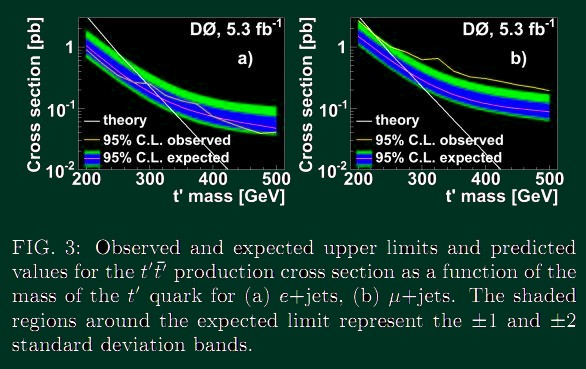To make the jungle of suspicious yet unreliable bumps found by particle physics experiments even more convoluted, the D0 Collaboration at the soon-to-be-euthanized Tevatron is reporting a result that doesn't exclude the fourth-generation quarks quite as expected:
Search for a fourth generation t' quark in ppbar collisions at sqrt{s}=1.96 TeVEvents that look like a fourth-generation top prime quark decaying into W+jets were expected to lead to a 320 GeV lower limit for the top prime quark mass.
However, the actual picture looks different.

Click to zoom in
Because the W-boson is unstable, the experimenters only have to observe its decay product - either an electron or a muon in this case. And only in the muon (plus those jets) channel, there is an apparent 2.5-sigma excess (see the right picture) equivalent to 99.3% confidence level.
It's most accurately eliminated or explained if one assumes a fourth-generation t' quark of mass 325 GeV. Of course, it may be surprising why it doesn't show up on the left picture as well which is one of many arguments why this excess is probably just another fluke. Another argument is that to explain the bump, the usual couplings of the new quark would have to be increased so that the cross section is enhanced 3.2 +- 1.1 times. Much like in the strange LHC case of the 115 GeV Higgs, the observed signal is several times larger than one expects from the simplest theory.
The value of 325 GeV is provoking for one more reason. First, it's the current lower bound on the fourth-generation bottom prime quark imposed by Tevatron. But there's something even more "positive" about 325 GeV.
The D0's competing collaboration at the Fermilab, the CDF Collaboration, has seen some would-be particle - two surprisingly similar events - decaying to four muons. The mass of the hypothetical particle was 324.8 or 325 GeV. Of course, in their "speculative story", the CDF would interpret it as a Higgs boson decaying to ZZ (each Z later goes to two muons) - and a Higgs is very different from a fourth-generation top quark. But note that the muon in the final state is also shared in these two stories, much like the mass.